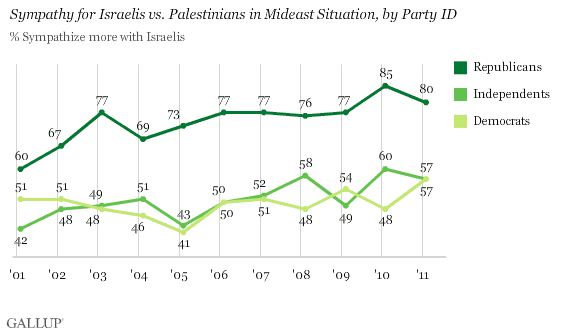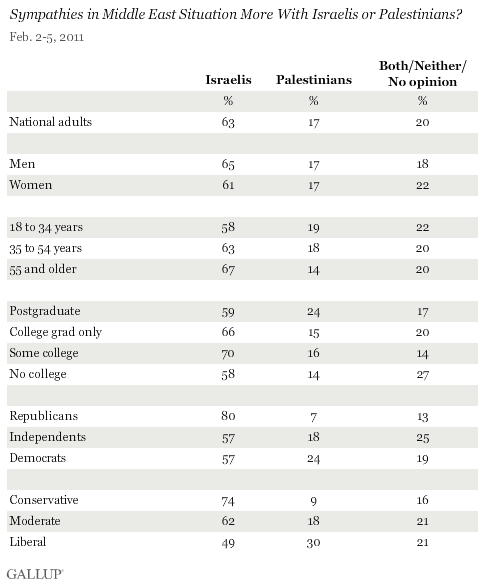PRINCETON, NJ -- Americans' views toward the Israeli-Palestinian conflict held fairly steady over the past year, with a near record-high 63% continuing to say their sympathies lie more with the Israelis. Seventeen percent sympathize more with the Palestinians.

In measuring Americans' sympathies toward the disputants in the Israeli-Palestinian conflict since 1988, ÆéûÜǨû§has found support for Israel consistently exceeding support for the Palestinians. However, the percentage who are neutral -- saying they sympathize equally with both, sympathize with neither, or expressing no opinion -- has shifted, with corresponding changes in support for Israel. While the reasons for these changes are not always evident, public neutrality was generally higher in the 1990s as the Palestinians and the Israelis often met at Clinton administration-sponsored peace summits.
Conversely, support for Israel increased during the 1991 Persian Gulf War, as well as immediately after the 9/11 attacks in 2001 and during the run-up to the 2003 Iraq war -- all events that may have enhanced Israel's perceived value to the U.S. as a Mideast ally. Sympathy toward Israel was also higher in polling conducted shortly after Hamas' victory in the 2006 Palestinian elections compared with the year prior, perhaps for the same reason.
The new results are from Gallup's Feb. 2-5, 2011, update of the annual ÆéûÜǨû§World Affairs survey, conducted as the citizen uprising in Egypt was unfolding.
In addition to the heavy tilt toward Israel in U.S. public sympathies, the poll finds a wide gap in Americans' overall views of Israel and the Palestinian Authority, according to a question asking separately whether they view each very favorably, mostly favorably, mostly unfavorably, or very unfavorably. About two-thirds of Americans have a favorable opinion of Israel and 19% have a favorable opinion of the Palestinian Authority -- largely unchanged from February 2010.

Range of Sympathy for Israel Bounded by Republicans and Liberals
Republicans continue to be Israel's strongest U.S. supporters: 80% sympathize more with the Israelis in the conflict, substantially higher than the 57% of independents and Democrats sharing this view. A similar pattern is seen by political ideology, ranging from 74% among conservatives to 49% among liberals -- with liberals the least supportive of Israel of any group ÆéûÜǨû§measured.
Over the past decade, Republicans have consistently shown greater support than Democrats for Israel; however, the partisan gap has widened, with Republicans becoming even more supportive between 2001 and 2003 and since 2009. Independents' support for Israel also increased to around 60% in recent years, up from 42% in 2001. At the same time, Democrats' support for Israel has been fairly flat.

All major U.S. population subgroups show greater sympathy for the Israelis than for the Palestinians. However, on a relative basis, Palestinians' greatest support is found among liberals (30%), followed by Democrats and those with postgraduate education (24% each).
Additionally, adults aged 18 to 34 are slightly less likely than those 55 and older to sympathize with the Israelis.

Bottom Line
In recent years, with no major breakthroughs in the Mideast peace process and no resolution to the Hamas vs. Fatah political rift in the Palestinian Territories, Americans' sympathies toward the conflict's players have leaned heavily toward the Israelis. In fact, with more than 60% of Americans sympathizing with Israel since 2010, public support for the Jewish state has been stronger than at any time other than in 1991, when Israel was hit by Iraqi Scud missiles during the Gulf War.
Israel currently enjoys popular U.S. support across all major party groups and most major societal subgroups; however, sympathy for it is particularly strong among Republicans and, relatedly, among conservatives.
Survey Methods
Results for this ÆéûÜǨû§poll are based on telephone interviews conducted Feb. 2-5, 2011, with a random sample of 1,015 adults, aged 18 and older, living in the continental U.S., selected using random-digit-dial sampling.
For results based on the total sample of national adults, one can say with 95% confidence that the maximum margin of sampling error is ôÝ4 percentage points.
Interviews are conducted with respondents on landline telephones (for respondents with a landline telephone) and cellular phones (for respondents who are cell phone-only). Each sample includes a minimum quota of 150 cell phone-only respondents and 850 landline respondents, with additional minimum quotas among landline respondents for gender within region. Landline respondents are chosen at random within each household on the basis of which member had the most recent birthday.
Samples are weighted by gender, age, race, education, region, and phone lines. Demographic weighting targets are based on the March 2010 Current Population Survey figures for the aged 18 and older non-institutionalized population living in continental U.S. telephone households. All reported margins of sampling error include the computed design effects for weighting and sample design.
In addition to sampling error, question wording and practical difficulties in conducting surveys can introduce error or bias into the findings of public opinion polls.
View methodology, full question results, and trend data.
For more details on Gallup's polling methodology, visit .
